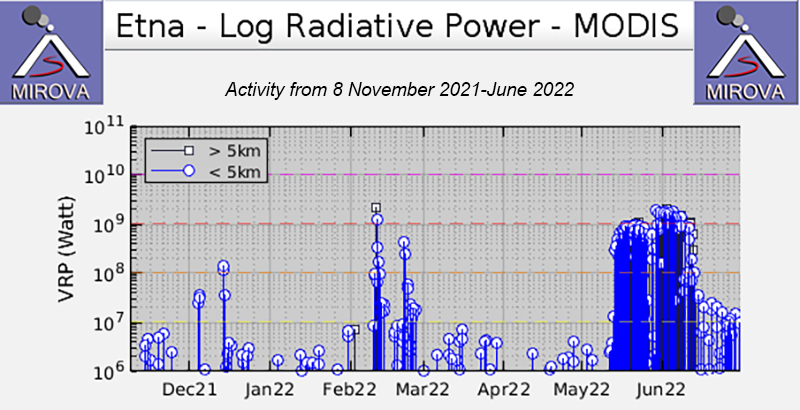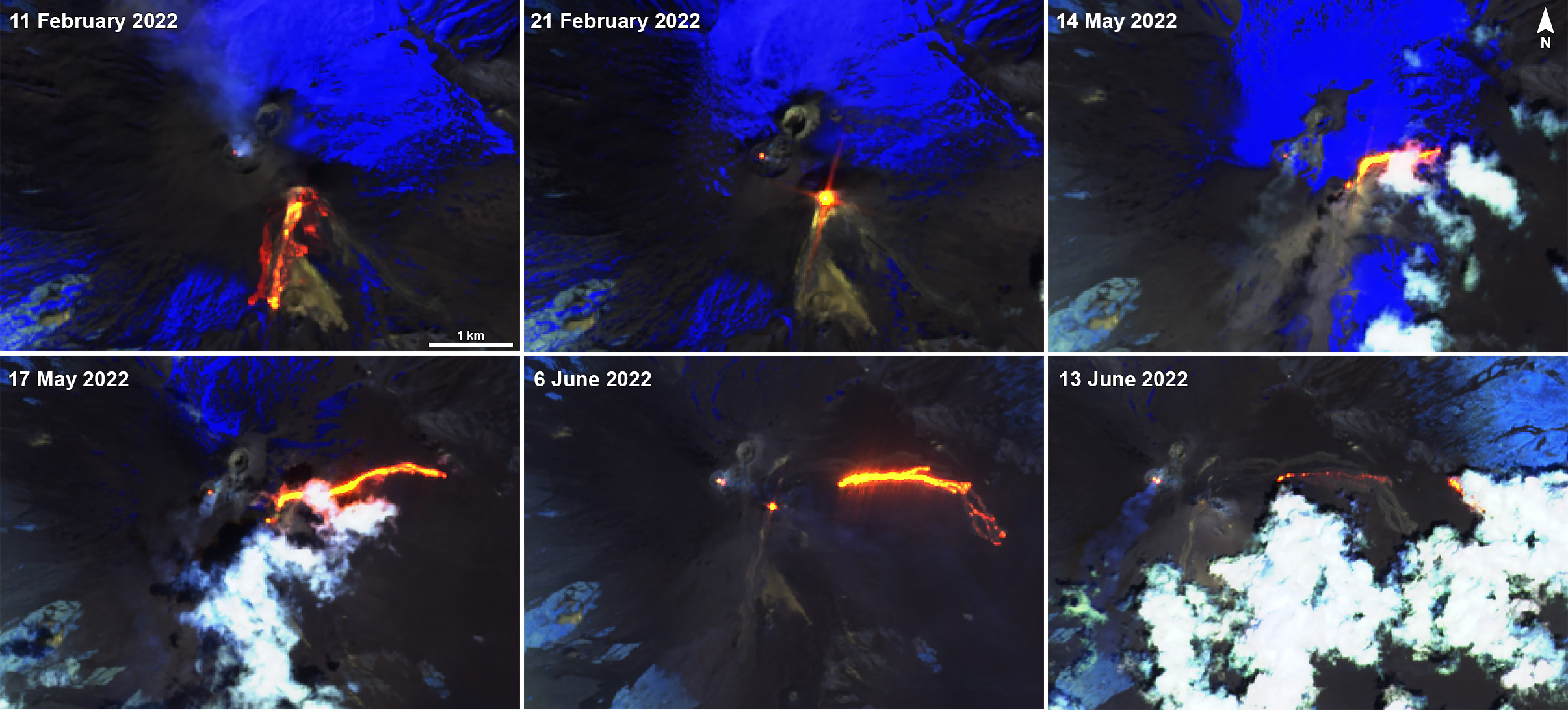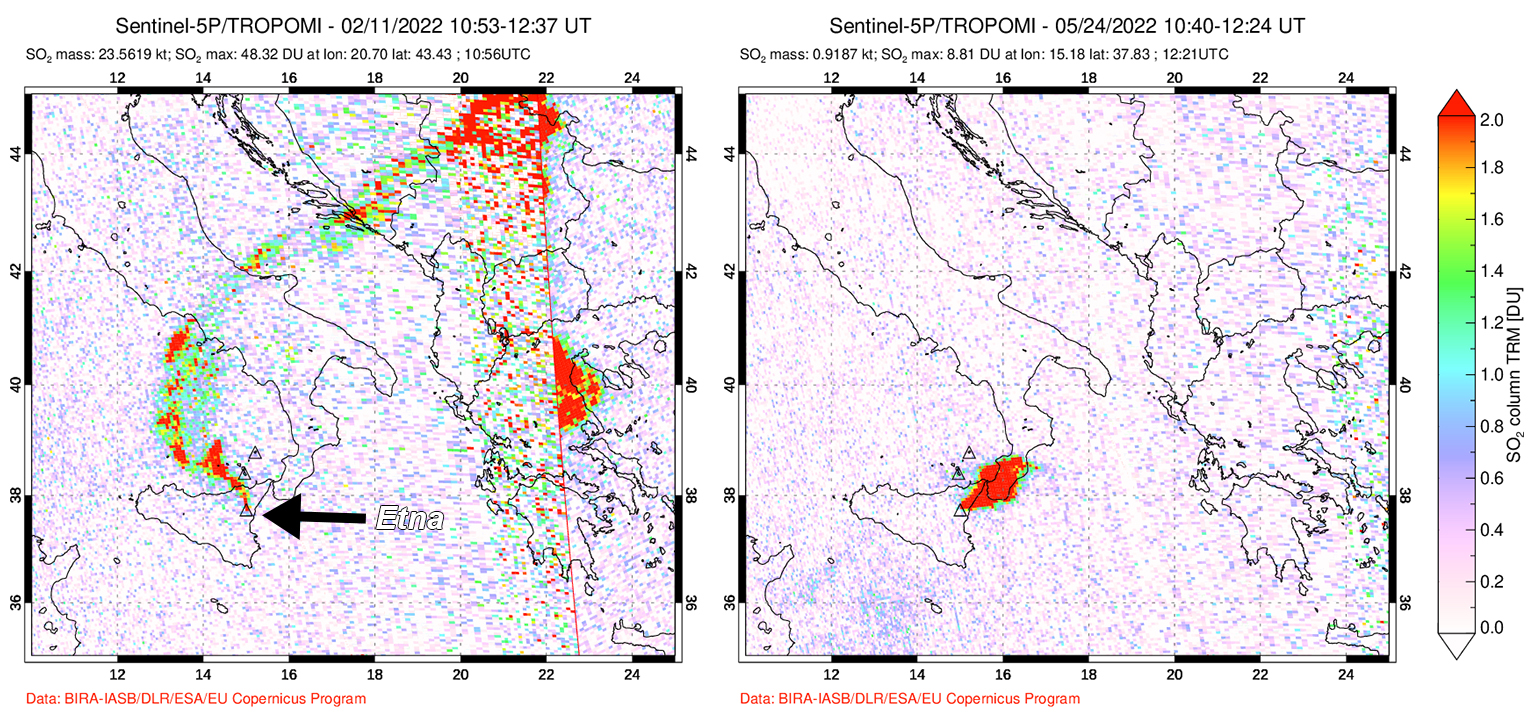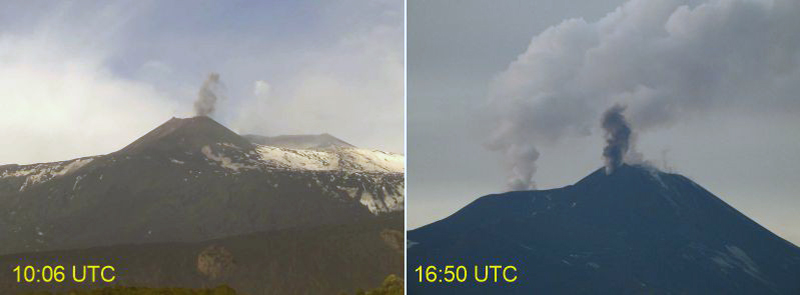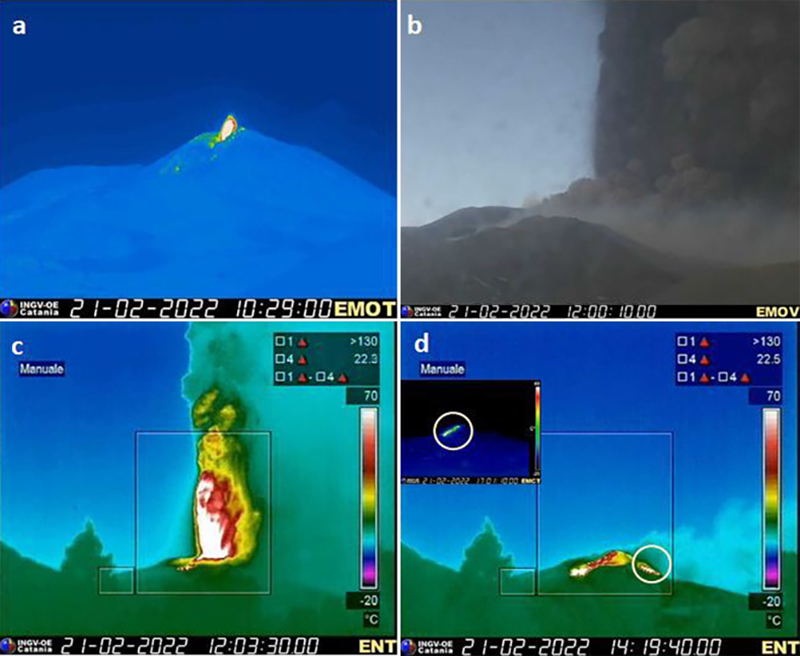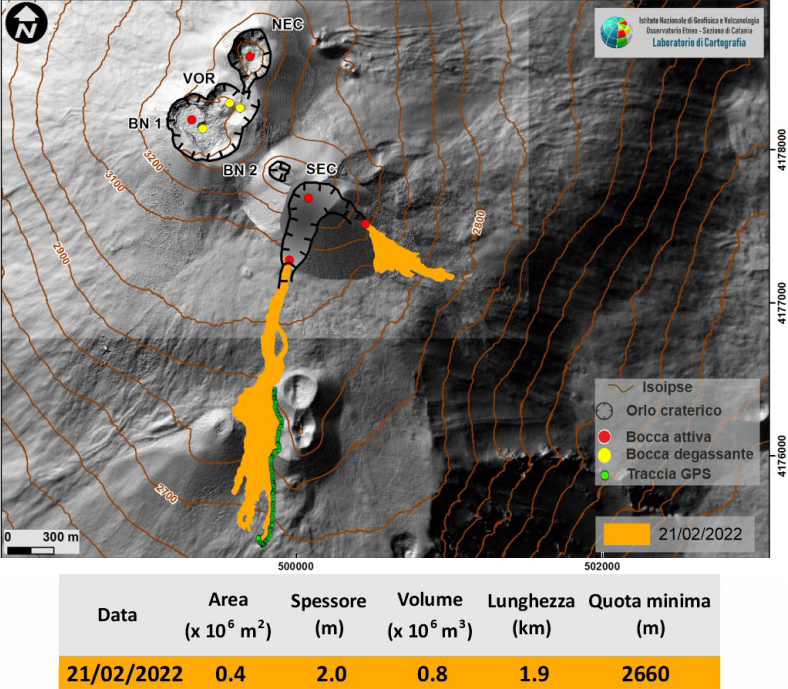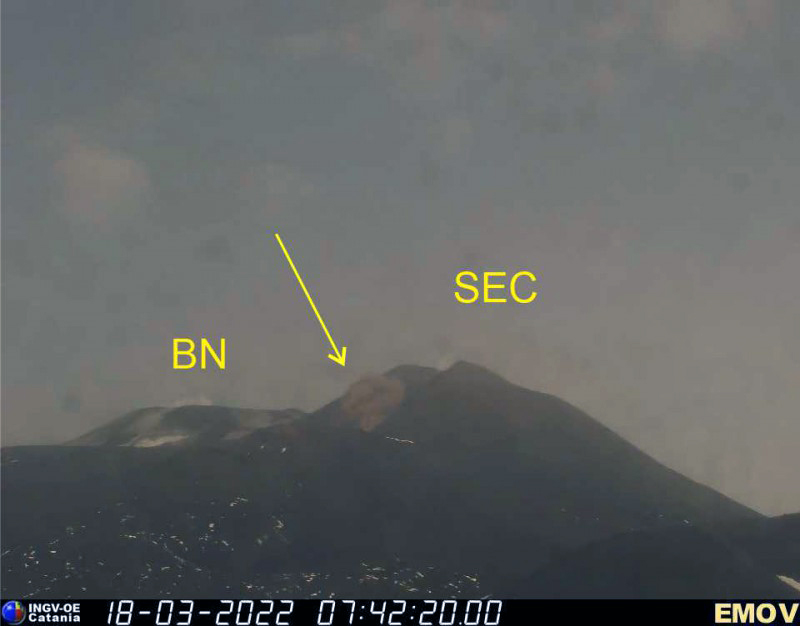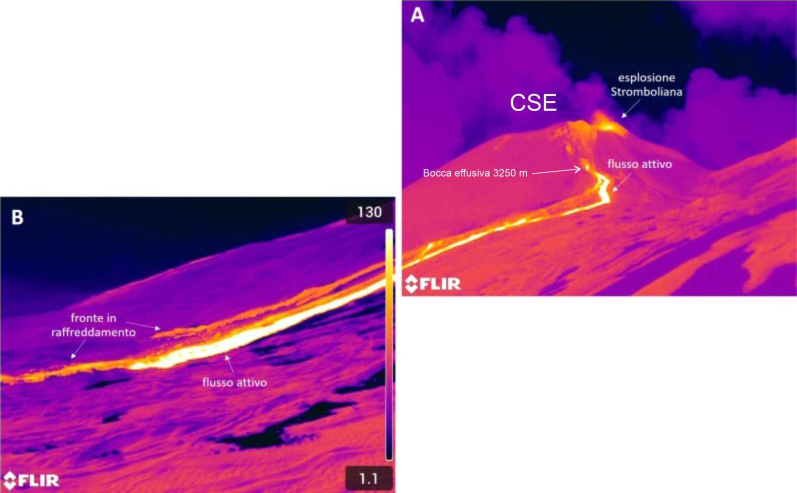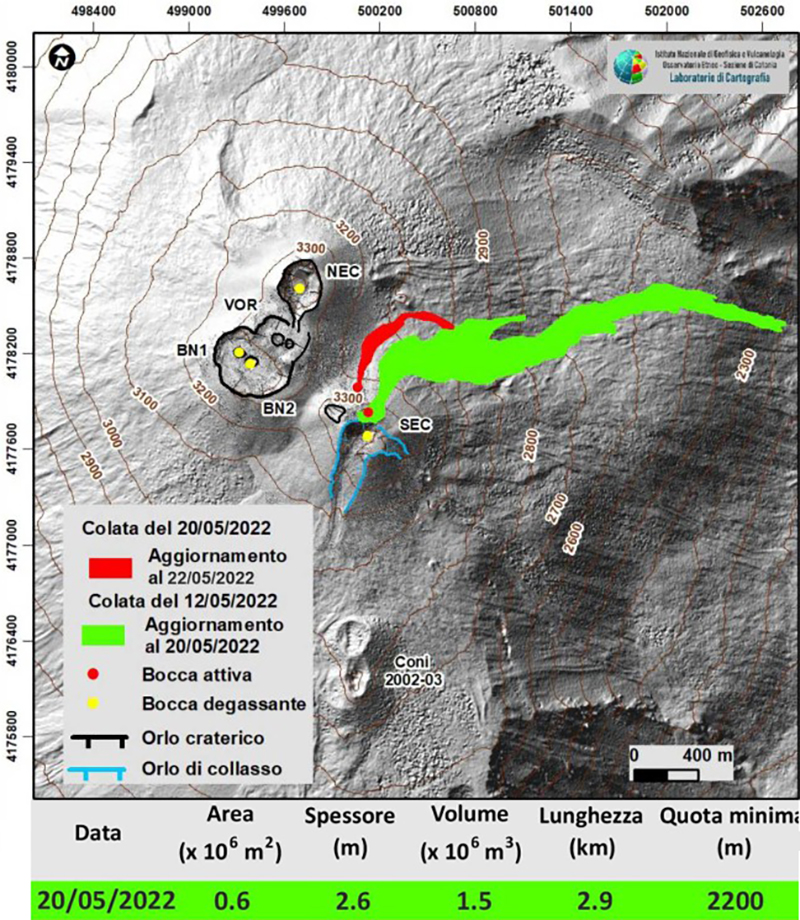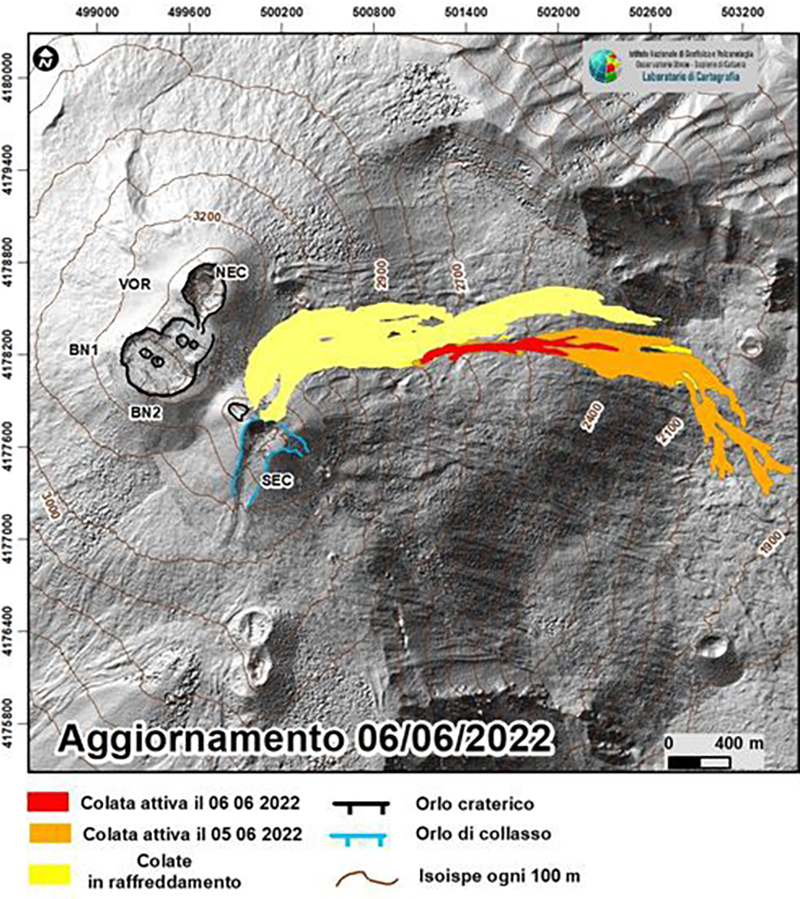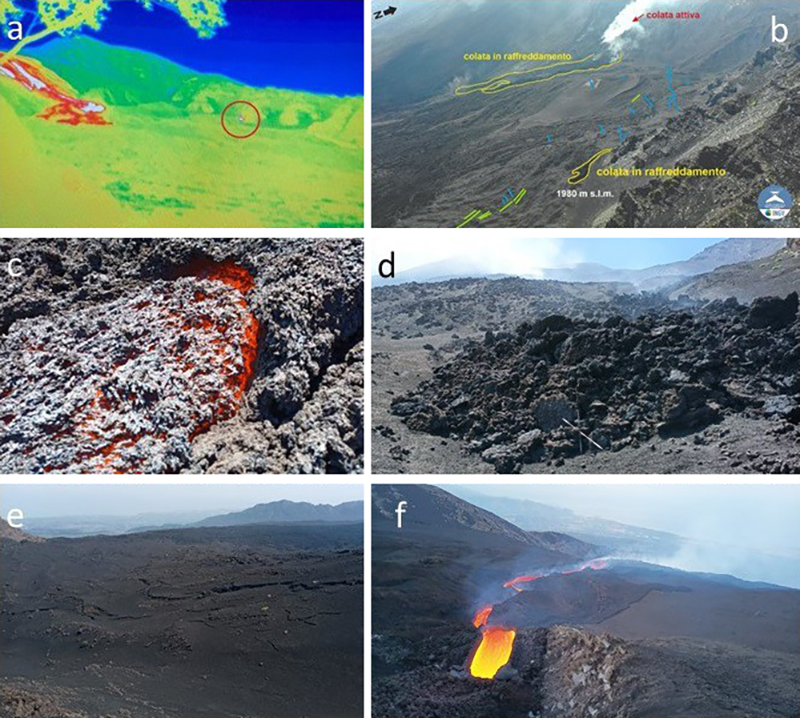Report on Etna (Italy) — July 2022
Bulletin of the Global Volcanism Network, vol. 47, no. 7 (July 2022)
Managing Editor: Edward Venzke.
Edited by Kadie L. Bennis.
Etna (Italy) Lava flows, pyroclastic flows, Strombolian explosions, and ash plumes during February-June 2022
Please cite this report as:
Global Volcanism Program, 2022. Report on Etna (Italy) (Bennis, K.L., and Venzke, E., eds.). Bulletin of the Global Volcanism Network, 47:7. Smithsonian Institution. https://doi.org/10.5479/si.GVP.BGVN202207-211060
Etna
Italy
37.748°N, 14.999°E; summit elev. 3357 m
All times are local (unless otherwise noted)
Etna is located on the island of Sicily, Italy, and has had documented records of eruptions dating back to 1500 BCE. Activity frequently originates from multiple cones at the summit, where several craters have formed and evolved. The currently active craters consist of Northeast Crater (NEC), Voragine (VOR), and Bocca Nuova (BN) that were formerly the “Central” crater, and the Southeast Crater (SEC). The original Southeast crater formed in 1978, and a second eruptive site that opened on its SE flank in 2011 was named the New Southeast Crater (NSEC). Another eruptive site between the SEC and NSEC was referred to as the "cono della sella" (saddle cone) and developed during early 2017. The current eruption period began in September 2013 and has consisted of Strombolian explosions, ash plumes, lava fountaining, pyroclastic flows, and lava flows associated primarily with the Southeast crater (SEC). This report covers continuing activity during February through June 2022, based on weekly and special reports by the Osservatorio Etneo (OE), part of the Catania Branch of Italy's Istituo Nazionale di Geofisica e Vulcanologica (INGV) and satellite data.
Summary of activity during February-June 2022. Most of the strong eruptive activity during February-June 2022 occurred in the Southeast Crater (SEC), which included Strombolian explosions, ash plumes, lava fountains, and lava flows. Persistent fumarolic activity at Bocca Nuova (BN), Voragine (VOR), and Northeast Crater (NEC) were accompanied by occasional diffuse ash emissions (table 12). Lava flows were reported by INGV during 10-11 and 21 February, 12, 20, and 29 May, and 6 and 11 June, moving SW, N, and NE. Lava fountaining occurred on 10 and 21 February. Pyroclastic flows were detected on 10 February, 12 May, and 20-21 May. Intermittent ash plumes rose to 3.5-12 km altitude throughout the reporting period, accompanied by Strombolian explosions. INGV reported that the eruption ended during the night of 15-16 June following effusive activity in the Valle del Bove.
A total of 201 MODVOLC thermal alerts were detected during the reporting period: 32 during February, 114 during May, and 71 during June. During these months specifically, INGV reported strong Strombolian explosions, lava fountains, and lava flows, which contributed to the stronger thermal activity detected in satellite data. These notable numbers also correlate to spikes detected in thermal activity in the MIROVA graph (figure 369). The lava flows that originated from SEC were also visible in Sentinel-2 infrared satellite imagery during February, May, and June, moving down the SW and NE flanks (figure 370). Accompanying this strong thermal activity were occasional sulfur dioxide plumes, as shown on 11 February and 24 May and recorded by the TROPOMI instrument on the Sentinel-5P satellite, where the emissions reached more than 2 Dobson Units (DU) and drifted generally N and NE (figure 371).
Table 12. Summary of activity at the four primary crater areas at the summit of Etna during February-June 2022. Information is from INGV weekly reports.
| Month | Bocca Nuova (BN) | Voragine (VOR) | Northeast Crater (NEC) | Southeast Crater (SEC) | Other activity |
| Feb 2022 | Variable degassing and sporadic and modest to dilute ash emissions. | Variable degassing. | Variable degassing and sporadic and modest ash emissions. | Mild and discontinuous degassing and ash emissions; modest Strombolian explosions. Lava effusions and fountains. | Ashfall in Viagrande, Trecastagni, Zafferana, Milo, Acicastello, Petrulli |
| Mar 2022 | Pulsating, discontinuous degassing. | Degassing from fumaroles around the crater rim. | Variable degassing and sporadic ash emissions. | Weak degassing from fumaroles; discontinuous Strombolian activity and dilute ash emissions. | -- |
| Apr 2022 | Variable and sometimes pulsating degassing. | No activity was detected. | Weak degassing. | Variable degassing. | -- |
| May 2022 | Pulsating, discontinuous degassing. | No activity was detected. | Variable degassing. | Degassing; Strombolian activity and dilute ash emissions, lava effusions. | Weak ashfall on the SE slope up to Catania |
| Jun 2022 | Variable degassing. | No activity was detected. | Variable degassing. | Degassing, Strombolian explosions, ash plumes, and lava effusions. | -- |
Activity during February 2022. Discontinuous Strombolian activity and mild ash emissions occurred at SEC during February, while degassing was reported at BN, NEC, and VOR. During the early morning of 2 February, the Strombolian explosions had stopped. On 10 February modest explosive activity resumed in SEC, as detected by video surveillance cameras. The activity was initially confined to the crater and generated discontinuous and mild ash emissions that drifted SW. As a result, there was a collapse detected on the S flank of SEC, which often showed a thermal anomaly in infrared cameras. That same day, at 1520, a new lava flow was visible from SEC that traveled WSW. The front of the flow reached an elevation of 2.9 km by 1956. At 2140 INGV reported a lava fountain at SEC, accompanied by an ash plume 8-10 km high that drifted W. Around 2140, 2219, and 2226, three pyroclastic flows breached the S flank of SEC, two of which traveled a few hundred meters toward the Valle Bove while the last one went S. As a result, some small collapses of material produced small ash emissions. This activity continued to be observed through the next day. By 11 February, the fountaining activity has stopped, but the lava flow from SEC continued, the front of which had advanced to 2.7 km elevation. On 11 February at 1107 the lava flow from SEC had stopped, though weak and discontinuous explosions persisted, emitted weak ash emissions that drifted to the NW. These explosions also resuspended and redeposited pyroclastic material in areas to the NW, particularly in Maletto and up to the Tyrrhenian coast of Sicily, in S Agata di Militello and Capo d'Orlando. A thermal anomaly was detected at the SE base of SEC the same day. On 15 and 18 February modest ash emissions occurred at NEC, which was deposited in the summit area.
Two small ash emissions from SEC were detected on 20 February (figure 372). INGV reported that on 21 February weak Strombolian activity persisted at SEC, accompanied by lava fountaining; an ash plume rose to 10 km altitude and drifted SE (figure 373). A lava overflow was detected around 1210 from SEC that descended toward the SW (figure 374). An ash plume was also visible, rising to 11 km altitude. By 1340 the lava fountaining stopped at SEC, but explosions continued, producing an ash plume that rose to 12 km altitude that drifted SSE. Some ashfall was reported in Viagrande, Trecastagni, and Zafferana. The lava flow continued to be fed weakly, the front of which is located at an elevation of 2.9 km and expanded to the E. Explosive activity in SEC stopped by 1350 on 21 February. INGV personnel in the field reported ashfall from the lava fountain activity in Viagrande, Milo, and Acicastello, and was mainly dispersed between Petrulli and Zafferana. After the fountaining a small pit crater formed and began showing signs of weak degassing. Additionally, surveillance cameras and INGV personnel reported another lava flow moving along the eastern slope of SEC, the front of which was at an estimated elevation of 2.9 km.
Weak Strombolian explosions were detected in SEC again during 22-25 February; during the morning of 23 February the lava flow moving along the lower E slope had started to cool. Several collapses were observed on the S flank of SEC and on the upper E slope following the lava fountaining, which caused fewer and more dilute ash puffs. On 24 February at 1338 surveillance cameras showed ash emissions rising above NEC that drifted SSE, followed by other less intense ash pulses.
Activity during March-April 2022. Activity during March and April was relatively low and consisted of gas-and-steam emissions from the summit craters, sporadic ash emissions from NEC, and modest collapses of material from the inner walls of SEC. Thermal activity in the summit area was low after the lava fountaining on 21 February. On 3 March a thermal anomaly was observed on the S inner wall of SEC associated with an ash cloud that rapidly dispersed into the atmosphere. According to INGV, the anomaly was likely caused by hot material that had accumulated during activity on 21 February. During the morning of 18 March a small ash emission was visible from the base of the S slope of SEC (figure 375).
An overflight on 8 April described intense gas-and-steam pulses from two vents in the center of BN. No activity was detected in VOR. Some small fumarolic activity and weak gas-and-steam emissions were observed in SEC and NEC. During the early morning hours of 27 April, very faint reddish ash emissions were observed in webcam images. Some degassing was also visible at SEC, mainly from fumaroles along the N crater rim and near the collapsed area from 10 February. On 21 April at 1006 a small landslide occurred on the S flank of the cone, accompanied by a thermal anomaly that was visible from the Montagnola camera. Another landslide event occurred at the same place on 22 April at 2214.
Activity during May 2022. Strombolian activity continued in SEC during May, occasionally accompanied by ash emissions. Some effusive activity was also reported in the Valle del Bove. On 9 May a mild ash emission was observed at SEC; similar and more frequent events occurred on the 11th. Thermal cameras showed an active vent on the upper N side of the cone. On 12 May at 1900 ash emissions intensified and rose to 3.5 km altitude from SEC to the SW from one or more vents along the N side of the crater. Small pyroclastic flows were reported on the N flank of SEC and reached the N base of the crater on 12 May. Additionally, a small lava flow effused from an eruptive vent and traveled N and NE into the snowy Valle del Leone, where lava blocks that rolled onto the snow caused gas-and-steam plumes. The SEC was also affected by discontinuous and variable Strombolian explosions, where the most intense phases ejected ash into the atmosphere, some of which dispersed to the SW during 14-15 May.
By 17 May the lava flow developed toward the ENE in the Valle del Leone, the front of which reached an elevation of 2.3-2.4 km. On 18 May the lava flow had begun to cool while new flows developed from the vent and followed the older flow (figure 376). On 20 May at 1730 a second effusive vent open on the N side of SEC at an elevation of 3.2 km. A small lava flow effused from this new vent that traveled NE (figure 377). During 20-21 May a pyroclastic flow originated from SEC and traveled NNE for 700 m. There was a gradual increase in explosive activity at SEC on 22 May at 1940, which produced ash emissions that rose to 5 km altitude and extended to the S. Weak ashfall was reported on the SE flank as far as Catania. At the same time, the lava emissions continued with varying intensity at the effusive vents formed on 12 and 20 May. On 29 May a third effusive vent opened in the upper part of the Valle del Bove and Strombolian activity at SEC stopped. Field observations showed that in the upper part of the W wall of the Valle del Bove there were two points of lava effusion along an eruptive fissure-oriented ENE. In the following days, low-rate effusion was reported, with flows reaching an elevation of 2.1 km. A series of fractures on the E side of SEC were noted at 3-3.2 km elevation; slope instability generated avalanches of material.
Activity during June 2022. Strombolian at SEC occasionally accompanied by ash emissions continued during June. Variable and pulsating effusive activity also persisted in the upper part of the Valle del Bove. Over time, the variability in effusion rate was reflected in the development of a branched lava field with overlapping flows. The flow fronts reached a maximum height of about 1.9 km altitude on 5 June and retreated to 2.4 km altitude on 6 June (figure 378).
Ongoing ash emissions reported on 1 June drifted SSE. Variable Strombolian activity continued and was accompanied by a lava flow on 2 June (figure 379). Particularly intense explosions during 1-3 June produced continuous ash emissions that dispersed SSE (figure 380). An ash plume on 3 June rose to 4-5 km altitude and drifted SSW. During the late afternoon on 7 June a new fracture opened at the base of the N wall of the Valle del Bove. Field observations reported a slightly active lava flow on 8 June that was mostly cooling and reached a maximum length of 170 m. On 11 June another new effusive vent at an elevation of 1.9 km fed another slightly active lava flow that expanded for a few tens of meters. A field inspection on 12 June showed a total of three active effusive vents; the most advanced lava flow front reached 1.8 km elevation (figure 381). During 13-14 June a single vent located at 1.9 km elevation produced a well-fed lava flow that had advanced to 1.8 km elevation on 14 June; by the night of 15 June the flow had stopped. Drone imagery from 14 June showed that small lava tunnels had developed, and two small vents located at 1.87 km and 1.95 km elevation had formed.
According to INGV, effusive activity in the Valle del Bove had stopped during the night of 15-16 June and no further eruptive activity was observed. Degassing at the summit craters continued except at VOR. Gas-and-steam emissions and some small fumaroles were observed rising from the inner walls of NEC.
Geological Summary. Mount Etna, towering above Catania on the island of Sicily, has one of the world's longest documented records of volcanism, dating back to 1500 BCE. Historical lava flows of basaltic composition cover much of the surface of this massive volcano, whose edifice is the highest and most voluminous in Italy. The Mongibello stratovolcano, truncated by several small calderas, was constructed during the late Pleistocene and Holocene over an older shield volcano. The most prominent morphological feature of Etna is the Valle del Bove, a 5 x 10 km caldera open to the east. Two styles of eruptive activity typically occur, sometimes simultaneously. Persistent explosive eruptions, sometimes with minor lava emissions, take place from one or more summit craters. Flank vents, typically with higher effusion rates, are less frequently active and originate from fissures that open progressively downward from near the summit (usually accompanied by Strombolian eruptions at the upper end). Cinder cones are commonly constructed over the vents of lower-flank lava flows. Lava flows extend to the foot of the volcano on all sides and have reached the sea over a broad area on the SE flank.
Information Contacts: Sezione di Catania - Osservatorio Etneo, Istituto Nazionale di Geofisica e Vulcanologia (INGV), Sezione di Catania, Piazza Roma 2, 95123 Catania, Italy (URL: http://www.ct.ingv.it/it/ ); MIROVA (Middle InfraRed Observation of Volcanic Activity), a collaborative project between the Universities of Turin and Florence (Italy) supported by the Centre for Volcanic Risk of the Italian Civil Protection Department (URL: http://www.mirovaweb.it/); Hawai'i Institute of Geophysics and Planetology (HIGP) - MODVOLC Thermal Alerts System, School of Ocean and Earth Science and Technology (SOEST), Univ. of Hawai'i, 2525 Correa Road, Honolulu, HI 96822, USA (URL: http://modis.higp.hawaii.edu/); Sentinel Hub Playground (URL: https://www.sentinel-hub.com/explore/sentinel-playground); NASA Global Sulfur Dioxide Monitoring Page, Atmospheric Chemistry and Dynamics Laboratory, NASA Goddard Space Flight Center (NASA/GSFC), 8800 Greenbelt Road, Goddard MD 20771, USA (URL: https://so2.gsfc.nasa.gov/).


